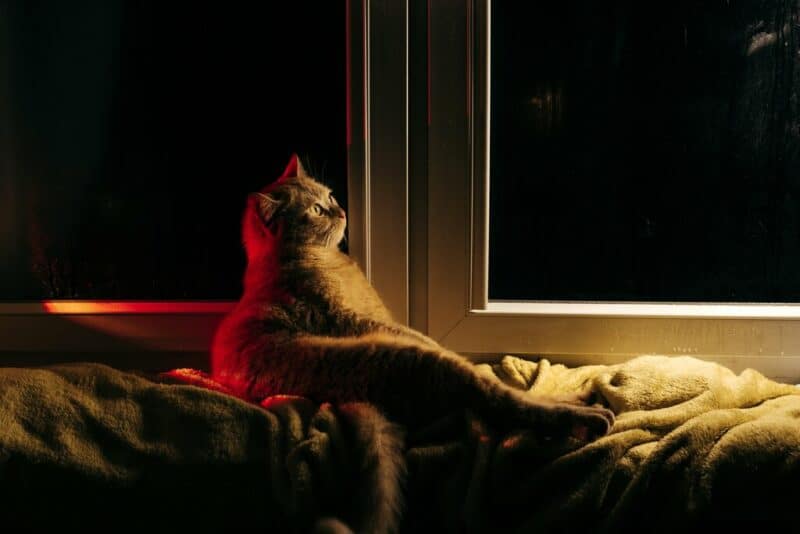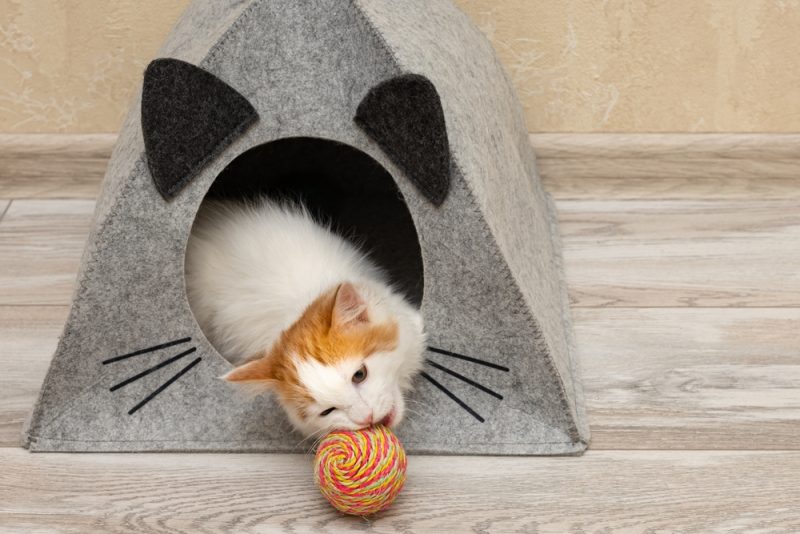Cat owners want to do everything they can to make sure their cats are comfortable, safe, and happy. Knowing that cats get up and play, hunt, or just move around the house in the middle of the night, some owners wonder if it’s a good idea to leave a light on, or even a nightlight, for their cats.
However, cats have very different vision and visual abilities to humans and as long as there is some light, they can see very well even in the middle of the night. Because of this, there is no reason to leave a light on for a healthy cat, although some cats, including those with certain visual impairments, may benefit.


Cat’s Eye
Cats have excellent eyesight in several ways. They have a wider field of vision than humans, so they can see what’s going on around them. They are also good at identifying or detecting any movement. While they can’t make out as much detail as humans can, they are really good when it comes to night vision. This is thanks to a reflective layer behind the eye.
The layer reflects light through the retina as it first passes through the eye. This allows cats to use even small amounts of light to see better even in very dark conditions.
In the wild, cats use their remarkable night vision to spot prey and combine this with their excellent ability to detect movement when hunting small animals. Despite the fact that they do most of their hunting at night, cats are not completely nocturnal. They are closer to being crepuscular, which means they are most active at dusk and dawn, which is when their prey is most active.
Unfortunately for owners, this means that our cats tend to get bursts of energy at sunset and again when it rises, and this is why domestic cats tend to to wake us up when the lights are out.

The 4 Reasons Not to Leave the Light On
Wild cats are crepuscular. They are most active at dusk and dawn, but pet cats don’t need to hunt or forage so you can encourage them to live at the same time as you do. And there are several reasons why you probably don’t want to leave the lights on at night for your cat.
1. Reduce Rowdy Playfulness
Cats thrive when it’s dark outside. This is natural but it is also embarrassing for the cat’s housemates. Although your cat can see well in low light, leaving the light on can encourage the cat to become rowdier and more excited.
2. Set Routines
If your cat is used to having the light on at night and not sleeping during the night hours, he will be less inclined to change it. It doesn’t just mean a sleepless night or two, either. This will likely lead to your cat developing routines throughout the night.
Whether that’s running up and down the stairs, using the opportunity for some heavy use of the scratch post, or anything else, it means the whole house will be subject to your cat’s nocturnal whims.

3. They See Around
Cats don’t need lights at night. Although they cannot see in complete darkness, they can see in almost any amount of dim light, including moonlight from outside or the glow of streetlights outside windows.
4. It Won’t Distract You
Even if it is a crack of light under the door, it can be enough to illuminate a dark room. Too much light, when combined with your cat’s noise because they’re awake and active, means you’re less likely to get a good night’s sleep.



When to Leave the Light On
Very young kittens can become anxious when they are first separated from their mother and littermates. It may be a good idea to leave the lights dim for the first couple of days while your new kitten settles in.
Also, if your cat has poor eyesight, it might be a good idea to leave a light on, so they have extra light to help them get around.
The 5 Tips to Calm Your Cat at Night
Some cats are noisy at night, even if you turn off the lights. Below are some tips to help calm your cat at night so the whole house can rest.
1. Keep Them Active During the Day
Despite their reputation as low-maintenance pets, cats need physical exercise and mental stimulation every day. Keeping their body and mind active during daylight hours will ensure they are tired enough to sleep through the night. Do this consistently to establish a routine that your cat will get used to. Cat TV, toys, music, training, climbing towers, and puzzles are great ways to keep your cat active.

2. Provide a Comfortable Place to Rest
Some cats can be comfortable anywhere. Others have very specific requirements and if you don’t meet those requirements, they won’t settle. Give your cat a comfortable bed and a blanket and make sure it is away from drafts and in a comfortable elevated position.
3. Offer peaceful Toys
Nighttime playtime is natural for cats, and it’s hard to stop it completely. However, you can make sure your cat has a healthy supply of peaceful toys to play with. Consider toys like lick mats and quiet balls, although no ball is completely quiet when it’s rolling on a hard floor or bouncing off a wall.

4. Set a Routine and Stick to it
Try to get into a routine with a set meal time for your cat, as well as a dedicated bedtime. You can vary the time a bit, but following a similar routine will get your cat into the habit of going to bed at the same time every night.
5. Avoid Playing Right Before Bed
Avoid playing with your cat right before bedtime and make sure you give them their dinner at least an hour before you want to go to bed. This will help induce rest and ensure you get a good night’s sleep as well.



Conclusion
Cats can see very well in very low light, even if that light is just moonlight or streetlight through a window. Because of this, you don’t have to leave the light on at night. In fact, doing so may encourage your cat to run around, play, and make noise.
Encourage rest by getting into a consistent routine including set evening meal times and lights out times.
Featured Image Credit: Mookmixsth, Shutterstock



